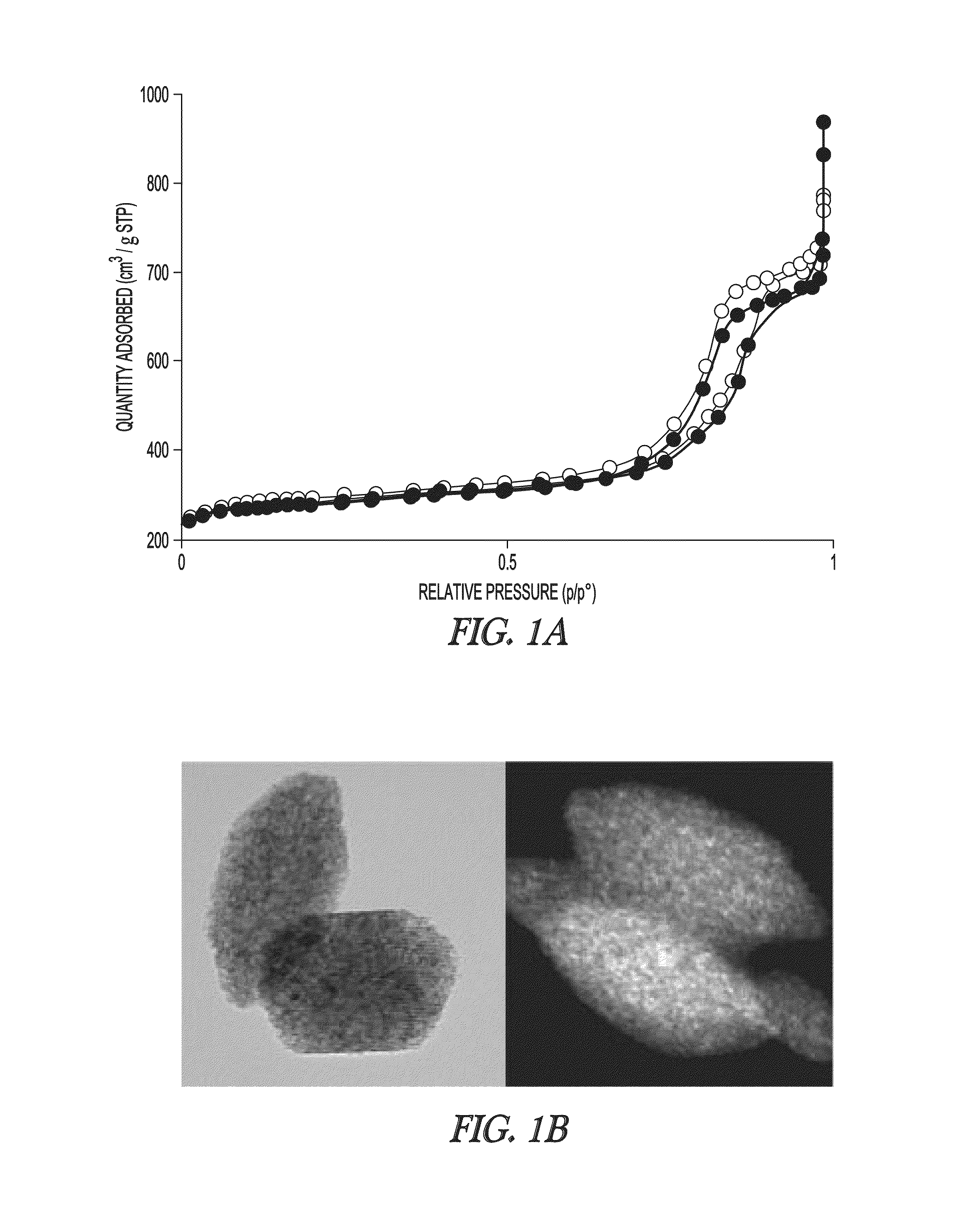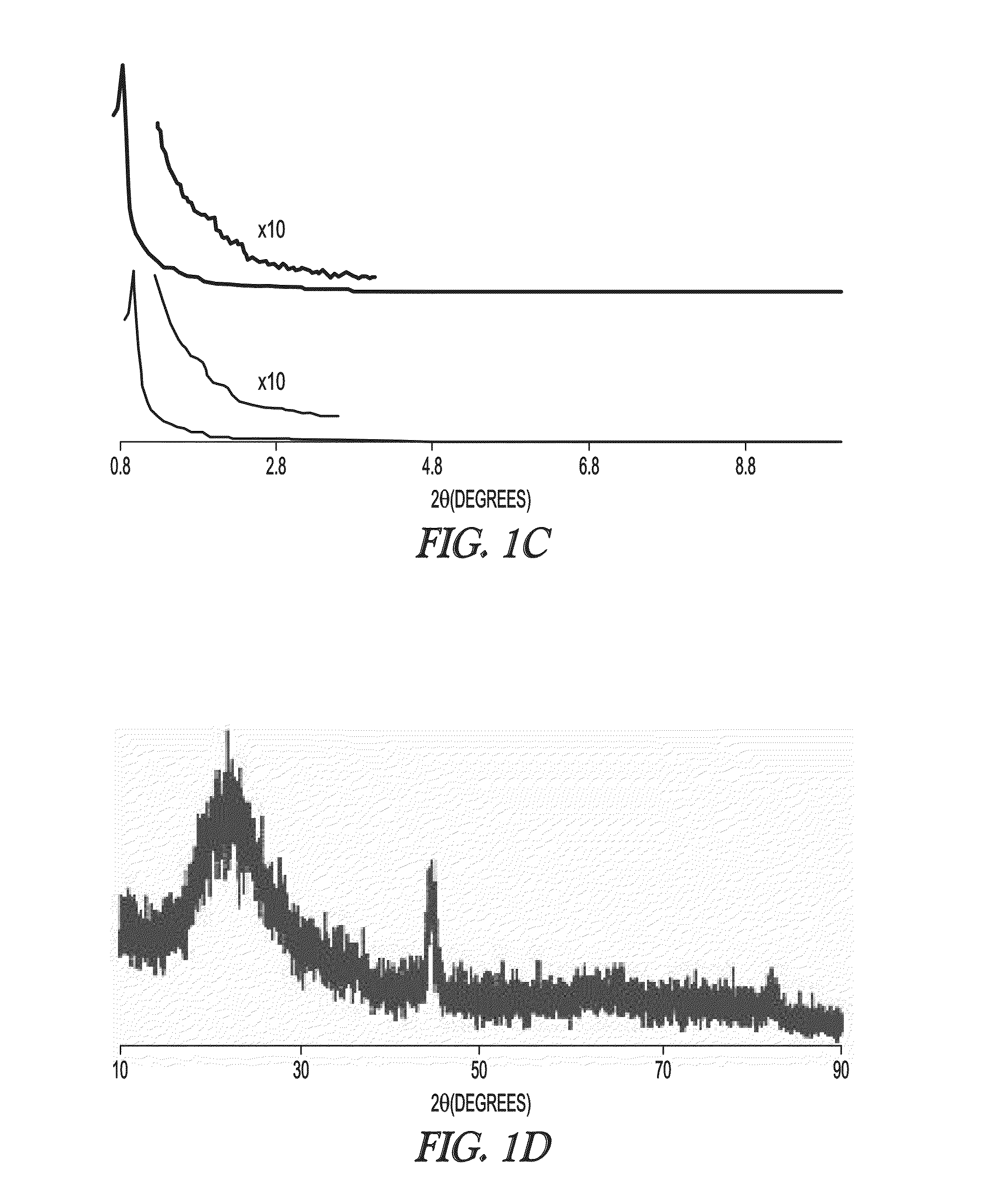Catalysts and methods of using the same
a technology of catalysts and catalysts, applied in the field of catalysts, can solve the problems of unselectively exposed catalysts to materials in a chemical reaction, and achieve the effects of reducing the c:o ratio, and improving the selectivity of hydrotreatment toward hydrodeoxygenation
- Summary
- Abstract
- Description
- Claims
- Application Information
AI Technical Summary
Benefits of technology
Problems solved by technology
Method used
Image
Examples
example 1
Mesoporous Silica Nanoparticles Including Iron Nanoparticles
[0107]Materials.
[0108]Pluronic P104 was generously provided by BASF. Tetramethyl ortho silicate (TMOS), oleic acid, and Sylon (BSTFA (N,O-bis(trimethylsilyl)trifluoroacetamide) and TMCS (trimethylchlorosilane), 99:1) were purchased from Sigma Aldrich. Iron (III) Nitrate [Fe(NO3)3.9H2O] was purchased from Fisher Scientific. All reagents were used as received without further purification.
[0109]Characterization.
[0110]Surface analysis of the catalyst was performed by nitrogen sorption isotherms in a Micromeritics Tristar analyzer. The surface areas were calculated by the Brunauer-Emmett-Teller (BET) method and the pore size distribution was calculated by the Barrett-Joyner-Halenda (BJH) method. The small angle powder X-ray diffraction (XRD) patterns were obtained with a Rigaku Ultima IV diffractometer using Cu target at 40 kV and 44 mA. Cu Kβ was removed using a monochromator. For transmission electron microscopy measurements, ...
example 1.1
Catalyst Preparation
[0113]MSN was prepared using a nonionic block co-polymer Pluronic P104 surfactant. In a typical synthesis, P104 (7.0 g) was dissolved in aqueous HCl (273.0 g, 1.6 M). After stirring for 1 h at 56° C., tetramethylorthosilicate (TMOS, 10.64 g) was added and stirred for additional 24 h. The resulting mixture was further hydrothermally treated for 24 h at 150° C. in a high-pressure reactor. Upon cooling to room temperature, the white solid was collected by filtration, washed with copious amounts of methanol and dried in air. To remove the surfactant P104, the MSN material was heated at a ramp rate of 1.5° C. min−1 and maintained at 550° C. for 6 h. MSN was then mixed with water and stirred at room temperature in order to rehydrate and regenerate the silanol groups, followed by filtration and drying. For impregnation, Fe(NO3)3.9H2O (0.40 mmol, 0.16 g) was completely dissolved in water (0.48 mL). To this solution, the rehydrated MSN (0.4 g) was added and mixed. The sol...
example 1.2
Properties of Fe-MSN
[0114]The textural properties of MSN support and Fe-MSN catalyst are summarized in Table 1. Inductively coupled plasma (ICP) measurement indicated 6.0 wt % Fe was immobilized on the MSN support. Formation of the Fe nanoparticles led to approximately 10% decrease in the surface area and pore volume of the support; however, its nitrogen sorption isotherm remained type IV, confirming retention of the mesoporous character (FIG. 1a, showing MSN (open circles) and Fe-MSN (filled circles)). TEM and scanning transmission electron microscopy (STEM) imaging suggested that the Fe nanoparticles were located mainly inside the pores of the MSN (FIG. 1b). Low angle XRD analysis confirmed that the structure of the support was not affected by the formation of Fe nanoparticles, as it preserved the p6 mm pattern typical of SBA-15 type materials (FIG. 1c, showing MSN (bottom) and Fe-MSN (top), with insets showing 10× magnified 110 and 200 reflections). Wide-angle XRD showed a patter...
PUM
| Property | Measurement | Unit |
|---|---|---|
| Temperature | aaaaa | aaaaa |
| Temperature | aaaaa | aaaaa |
| Fraction | aaaaa | aaaaa |
Abstract
Description
Claims
Application Information
 Login to View More
Login to View More - R&D
- Intellectual Property
- Life Sciences
- Materials
- Tech Scout
- Unparalleled Data Quality
- Higher Quality Content
- 60% Fewer Hallucinations
Browse by: Latest US Patents, China's latest patents, Technical Efficacy Thesaurus, Application Domain, Technology Topic, Popular Technical Reports.
© 2025 PatSnap. All rights reserved.Legal|Privacy policy|Modern Slavery Act Transparency Statement|Sitemap|About US| Contact US: help@patsnap.com



